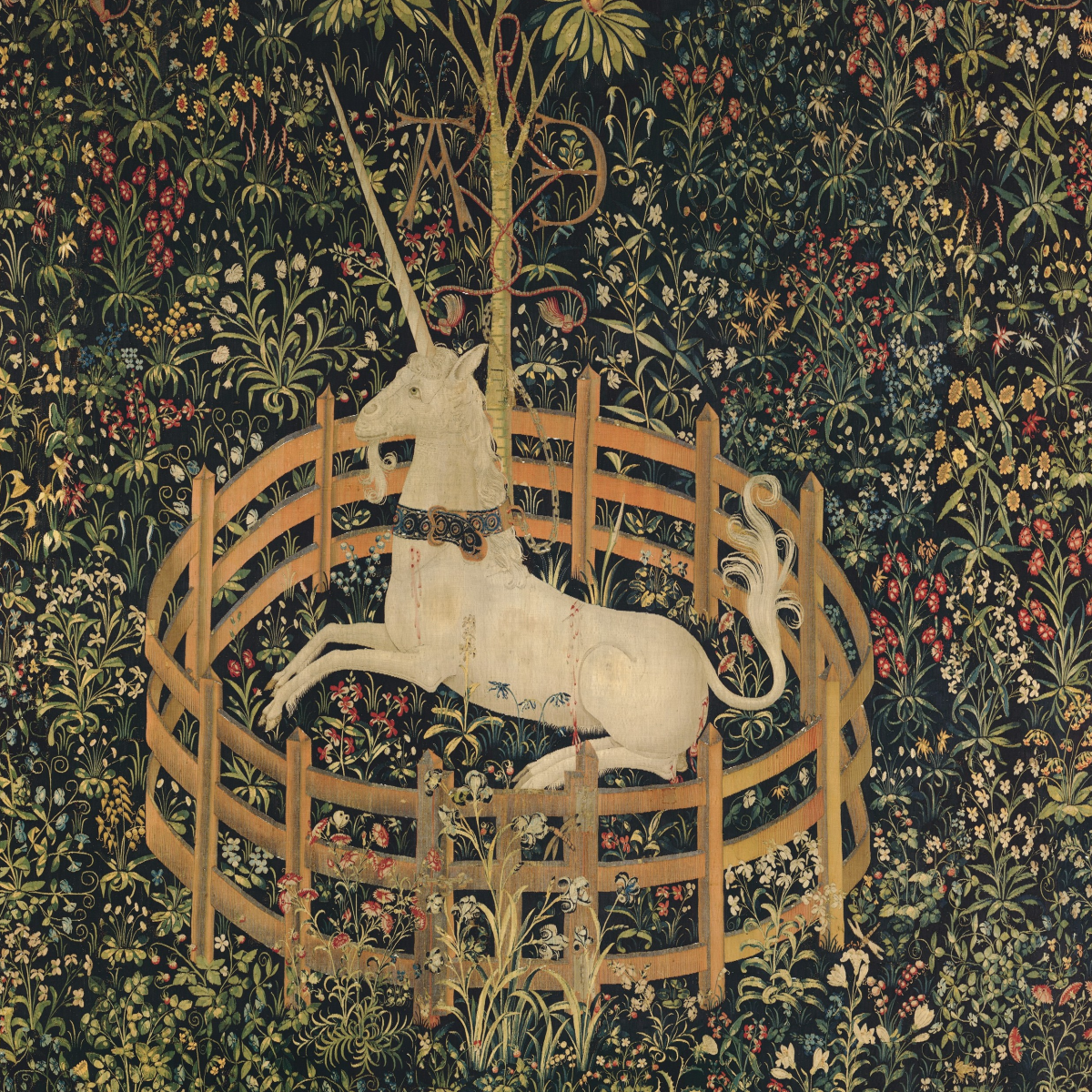The tapestry known as The Unicorn Rests in a Garden has fascinated me for much of my life. A print of it hung on the wall of my childhood bedroom, and I remember spending a great deal of time examining the flowers, admiring the unicorn, and wondering what the letters “A” and “E” meant.
I lost track of this unicorn print during college, but when I was pregnant with our first child, we took a trip to France, and I came across it as a mini tapestry. I purchased it to decorate the baby’s room. Now, with the kids pretty much grown, it hangs above my desk.

I realized recently that I didn’t actually know much about the original tapestry, which inspired my treasured reproductions. I did a quick search online and discovered that it is part of a series of tapestries, which explore the legend of the hunt of the unicorn. And so I began to research The Unicorn Rests in a Garden and its companion tapestries more earnestly in order to learn and share with you.
In my last post, we explored unicorns in general in order to set ourselves up to better appreciate the tapestries we’ll discuss in this post. If you’re new to my blog (welcome!) or would like to refresh your memory, here’s a link to read last month’s post on unicorns (legend and history).
A Brief History of the Hunt for the Unicorn Tapestries
The Unicorn Rests in a Garden currently hangs in The Cloisters as part of The Metropolitan Museum of Art in New York. The tapestry is one in a series known as the Hunt for the Unicorn tapestries (also sometimes referred to as The Unicorn Tapestries). They are complex tapestries woven with silver and gilded threads from materials such as wool and silk.
While it’s not possible to describe the exact origins of these seven tapestries (it’s still a mystery to this day), it’s generally accepted that they were crafted in the late Middle Ages, most likely around 1500. This has been determined by both the style of the tapestries and the clothing worn by the people depicted in the tapestries.
The Unicorn Rests in a Garden, along with the other tapestries in the Hunt for the Unicorn series, are some of the few surviving tapestries that explore the legend of the unicorn. Their first documented appearance was at the former Hôtel de Liancourt in Paris. They were listed as part of an inventory taken in 1680 of the belongings of François VI de La Rochefoucauld, who had recently died.
At some point between 1680 and 1728, the tapestries were relocated to the La Rochefoucauld family château in the Charente. Although the château was invaded and ransacked during the French Revolution, the tapestries survived. Barbara Drake Boehm, in The Metropolitan Museum of Art Bulletin entitled A Blessing of Unicorns: The Paris and Cloisters Tapestries, explains:
… but the “old tapestries” were spared since they did not have royal emblems and only told “stories,” and therefore did not, in the view of the revolutionary authorities, constitute pro-royalist propaganda. Still, soon thereafter, residents of the village appropriated the tapestries to cover their potatoes in winter.
While protecting the village potatoes with the Hunt for the Unicorn tapestries does make sense from a practical standpoint, I feel like it might have also been a statement on the inequalities of French society existing at that time. But this is just my guess. Eventually, in 1856, the tapestries made their way back to the La Rochefoucauld family château. Boehm writes that they remained there “… until their sale by the La Rochefoucauld heirs in the 1920s led to their purchase by John D. Rockefeller, Jr., who generously donated them to the Cloisters in time for its opening, in 1938.” And at the Cloisters they can still be found.
A Unicorn Hunt as Depicted in the Tapestries
Margaret B. Freeman writes in her book, The Unicorn Tapestries, that these tapestries (along with another set of unicorn themed tapestries in the Musée de Cluny) “… have helped considerably to keep the unicorn image alive to the present day.” Crafted in a time when “everyone believed in unicorns,” they depict “… the most completely realized hunt of the unicorn that the Middle Ages produced.” In last month’s post we discussed the general storyline of this hunt—now we will see how it’s displayed through the tapestries.

The first tapestry, entitled The Hunters Enter the Woods, shows hunters pausing with their dogs just before they enter the forest in search of the elusive unicorn. Up in the top right corner, a scout signals to them—he’s spotted the unicorn. Moving to the second tapestry, The Unicorn Purifies Water, the hunters have discovered the unicorn dipping his horn into a stream, purifying the water of any poisons so that the other animals may safely drink from it.

In the third tapestry, The Unicorn Crosses a Stream, the hunt has begun. Although chased by the dogs and the hunters with spears, the unicorn crosses the stream and escapes. But in the fourth tapestry, The Unicorn Defends Himself, the unicorn kicks at a hunter and attacks a dog with his horn, fighting hard to make capture difficult.

At this point, the fifth tapestry reveals that the hunters have shifted gears: rather than trying to capture the unicorn by force, they decide to try to tame the unicorn with the help of a maiden. The Unicorn Surrenders to a Maiden tapestry harkens back to the Physiologus and the bestiaries that evolved from it. Recalling what we discussed last month, the Physiologus includes the details for taming a unicorn with the help of a virgin maiden. Freeman, in The Unicorn Tapestries, explains that “The capture of the unicorn by means of a virgin girl,… is by far the best-loved unicorn theme of the Middle Ages.”
The Unicorn Surrenders to a Maiden tapestry, damaged over the centuries, no longer shows the maiden in full—only her arm and fingers can be seen. The woman we can see is a handmaiden, who seems to be signaling to the hunter with the horn that the unicorn is now tame and can be captured. The Hunters Return to the Castle, the sixth tapestry, reveals two scenes: in the top left corner the unicorn is tragically killed by the hunters, while the rest of the tapestry shows the hunters returning to the castle with a horse carrying the prized unicorn on his back.
But fear not—the last (and my favorite!) tapestry remains. In the seventh tapestry, The Unicorn Rests in a Garden, the unicorn is found to be alive, albeit in an enclosure and restrained by a chaine d’amour, but seemingly content. As in all of the tapestries, symbolism abounds in this tapestry. It would be too lengthy for this post to dig into all seven tapestries, so we will only look into the seventh tapestry as an example.
Details and Symbolism of The Unicorn Rests in a Garden

Before you spend too much time wondering what the letters “A” and “E” might mean, I shall sadly let you know that it remains a mystery. It may be a reference to the person(s) for whom the tapestry was woven, but no one is certain.
What is known is that The Unicorn Rests in a Garden appears to hold themes of marriage and fertility within its threads. Like the other tapestries, it is a type known as millefleurs, meaning “a thousand flowers.” In The Unicorn Tapestries, Margaret B. Freeman elaborates on the dual purpose of the many plants from a medieval standpoint:
A large number of the plants in the Cloisters’ tapestries [Hunt for the Unicorn series] were undoubtedly chosen because of their symbolic significance; but almost all, to the medieval observer, would have been meaningful as well as beautiful.
To pursue a bit of the flora symbolism, the stylized tree to which the unicorn is chained bears pomegranates, which were symbols of fertility. (Side note: it is believed that it is pomegranate juice and seeds dripping onto the unicorn, not blood.) The Unicorn Rests in a Garden tapestry also displays carnations and Madonna lilies as symbols of marriage, as well as wild orchid and thistle, which were used as fertility aids in the Middle Ages.
From an animal standpoint, the unicorn isn’t alone in the garden—there are hovering insects, including a butterfly (to symbolize love and fertility), and a resting frog (known for its mating calls as described by medieval writers). Like the plants, the symbolism of these animals adds depth to the themes of marriage and fertility presented in the tapestry.
Connecting Unicorn Legend and Mythology to the Hunt for the Unicorn Tapestries
Through my research, I discovered that we can draw several connections between what we learned last month about the history and legend of unicorns and the Hunt for the Unicorn tapestries. The first is the most literal: the tapestries follow the story of the unicorn hunt, including the mythology of the unicorn using its horn to purify water, and the legend of it being tamed by a maiden so that it may be captured and taken to the castle as a prize.
There exists a secular interpretation, which extends the literal unicorn hunt into “an allegorical love-hunt” or marriage story. Many poets and romantic writers likened the unicorn’s capture by a maiden to a lover beguiled and devoted to his true love.
Finally, as we learned last month, the unicorn appeared in the Bible and served as a representation of Christ. As such, a religious interpretation of the tapestry series exists as well. Margaret B. Freeman summarizes this well in The Unicorn Tapestries:
Thus the story of the unicorn, in the texts and in the tapestries, may be interpreted as an allegory of the whole divine plan for the redemption of sinful man: the Incarnation of Christ, the pursuit of him by his enemies, his condemnation and death on the cross, and his resurrection “to the palace of the heavenly king.” The last tapestry, in which the unicorn rests in a garden of flowers, may symbolize the resurrected Christ as he shows himself to the saints and angels of heaven.
Perhaps all three views resonate with you, or maybe only one or two. For me, I love that I can now look at the art on my wall with new understanding and appreciation beyond simply admiring the majestic unicorn.
Art credit (featured image): The Unicorn Rests in a Garden, from the Hunt for the Unicorn tapestries via The Metropolitan Museum of Art, licensed under CC0




